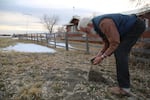In a desert far from any city, farmers use groundwater to grow lush, green hay. The hay then goes to fatten livestock all over the world. But there’s a big problem — the water is drying up. And scientists warn it will take thousands of years for the aquifer in Harney County to recover.
At Marjorie and John Thelen’s house, the well ran dry in 2015. “We're not ranchers; we're not growing hay. We're just retired in the country,” said 72-year-old Marjorie Thelen, who moved to southeastern Oregon with her husband 12 years ago.
Impressed by the mountain views and rambling sagebrush, they bought a modest house near Burns. Then, hay farming boomed around them.
“It was like a goldrush,” said John Thelen, 78, describing how giant steel sprinklers cropped up after the state warned of water scarcity in 2016.

John Thelen stoops for a handful of sand pumped out by a well, before it ran dry.
Emily Cureton / OPB
He dreads the growing season: “It’s like having your arteries cut open and watching the blood run out, when your water is being sprayed to the wind and it’s evaporating away at humongous quantities.”
Like most people in this dry valley, the couple’s drinking water comes out of the ground. When their well failed, they paid thousands out of pocket to drill deeper, only to find water with high levels of arsenic. Now, their kitchen is cluttered with plastic bottles. A cup of tea starts with a filtration system.
The Thelens say enough is enough: It’s time to stop irrigating in the desert.
In situations of scarcity, the Oregon Water Resources Department has the power to shut off water on the basis of seniority, a centuries-old system farmers say will plunge the region into a depression.
For years, OWRD enabled excessive pumping in the basin, permitting new wells long after it had data showing groundwater depletion. Now that alarm bells are ringing, the agency is advancing a voluntary approach to conservation.
Harney County commissioner and hay farmer Mark Owens said gradual conservation measures, not a sudden shut off, are critical for the region’s economic survival. He argued that if farms go out of business, it would devastate the tax base, crippling schools, roads, libraries and law enforcement. Besides that, he said, hay fields aren’t the final destination for the water.

Harney County Commissioner and hay farmer Mark Owens, Dec. 12, 2019.
Emily Cureton / OPB
“I use a lot of water, but the crops that I raise go to Tillamook to produce the milk in the ice cream that you eat, or the grains to feed the beef that you eat,” Owens said.
A Republican running for Oregon House District 60, Owens supports cutting back water use by a few percent every year and subsidizing farms that retire land from irrigation.
“This issue that's happening in [the] Harney basin is going to happen in a community next to you. If it's not, just wait,” he said. “We have to protect agriculture because the end user of the water is all of us.”
Over the last few years Owens has gotten to know a group of scientists studying the Harney basin. Before these conversations, he said, “I honestly thought that we were getting groundwater from thousands of miles away.”
That’s not the case.
The Oregon Water Resources Department and the U.S. Geological Survey recently warned the aquifer is out of balance.
Related: 5 Essential Questions About Harney County's Water Crisis
Irrigation accounts for roughly 97% of the region’s groundwater use, and these powerful wells drain isolated pockets of water much faster than they refill. Groundwater pumped out in just a few decades took thousands of years to accumulate. Pressure from the wells has changed the gradient in some places, making it impossible for water to come back. And because of the region’s volcanic geology, rain and snowmelt don’t penetrate deeply in some areas, at least not on the scale of human societies.
Historically, policymakers in the West divvied up groundwater like it was coming from a giant subterranean ocean that would never run dry.
“I'll give you an example. In 1904, a Texas Supreme Court ruling found that groundwater was so secret, occult and concealed that it was too difficult to legally control it,” explained Todd Jarvis, director of the Institute for Water and Watersheds at Oregon State University.
More than a hundred years later, this mindset is just starting to change. Texas now has groundwater conservation districts. Utah allows pooling water rights to create proportional shares, rather than privileging the oldest claims first. California recently became the first state to pass a law requiring sustainable groundwater management.
And at an Oregon dinner table with Swedish meatballs and creamed corn, people in conflict are working toward the state’s first-ever voluntary conservation agreement.
“I want to thank you for the food,” Oregon Water Resources Department Director Tom Byler said to a roomful of Harney County residents in December.
“There are a lot of hard conversations ahead, but watching this group in action gives me a lot of hope.”

Oregon Water Resources Department Planner Harmony Burright speaks to Harney County residents at a collaborative meeting, Dec. 12, 2019.
Emily Cureton / OPB
A voluntary water conservation agreement has never succeeded in Oregon before. An attempt in the water-challenged Wallowa basin failed. For Brenda Smith of the High Desert Partnership, a successful collaboration is all about relationships.
"It’s a thousand cups of coffee,” said Smith, whose nonprofit mediates natural resource conflicts in eastern Oregon.
She admits building consensus is slow work. “But if you're going to fight about it, we don't have that time either,” she said.
Smith said she thinks after decades of conflict over the creation of the Malheur National Wildlife Refuge, people got tired of fighting. They worked together to agree on a collaborative management plan there, which became a national model for balancing grazing interests with wildlife and wetlands. The plan built relationships between ranchers and federal land managers. In 2016, those connections took steam out of an armed occupation at the refuge. Militia leaders from outside the area hoped local ranchers would take up arms against the federal government, but that didn’t happen.
Now, the region’s very survival is on the line: drinking water, the economy and the environment. People in Harney County have been having meals and collaborative meetings for years to address the impending crisis. At a recent meeting, they formed a circle, where hay farmers like Owens, who want to change slowly, sat across from homeowners like the Thelens, who want decisive action now.
They've agreed, the goal is to find common ground, before it’s too late.

A truck loaded with hay bales leaves Harney County, Oregon on Dec. 13, 2019.
Emily Cureton / OPB

